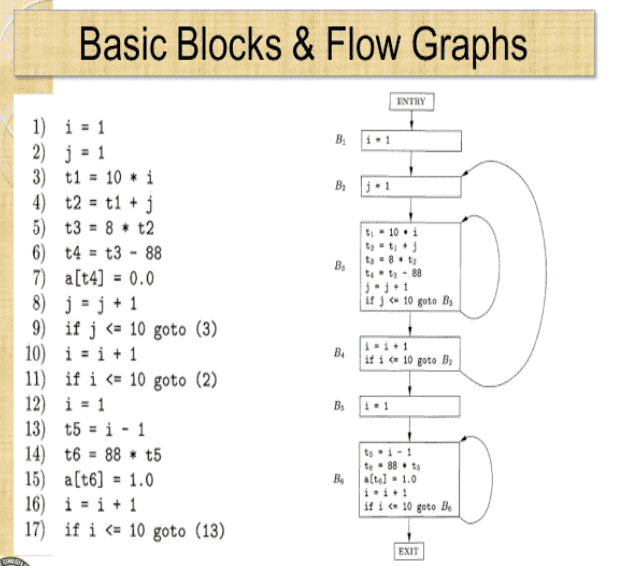07 Intermediate Code Generation
Ideally the details of source language are confined to the front end and the details of target machines to the back end.

Why IC?¶
Rather than creating a compiler for every language to translate code for every machine arch, we create a compiler for every language to translate code to IC; this IC is then translated for the machine arch.
This reduces complexity from \((m \times n) \to (m+n)\), where \(m\) and \(n\) are number of prog languages and machine arch respectively.
Properties of IC¶
-
easy to produce
-
easy to translate into target machine code
-
Three-address code (TAC)
consisting of sequence of assembly-like three-operand instructions of the form \(x = y \text{ op } z\)
- Postfix notation
Abstract Syntax Tree¶
Binary tree where
- Leaves represent operands
- Non-terminals represent operators
Eg: \(a+a*(b-c) +(b-c)*d\)¶
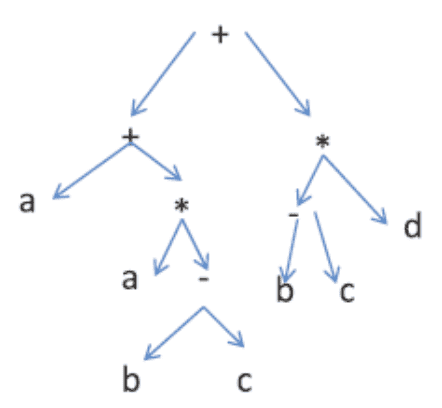
Directed Acyclic Graph (DAG)¶
AST where all subexpressions of an expression (even repeated subexpressions) occur only once.
This helps the compiler generate more efficient code.
Eg: \(a+a*(b-c)+(b-c)*d\)¶
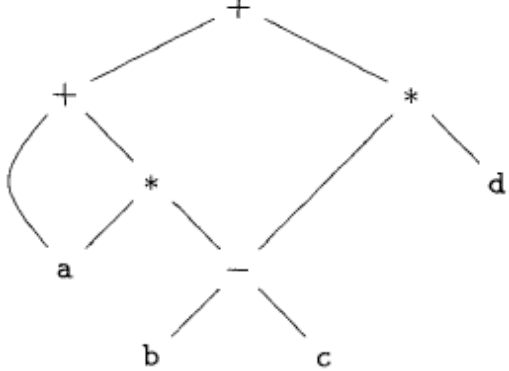
Eg: \(i=i+10\)¶

Steps for tree representation¶
- Check whether an identical node already exists
- If yes, the existing node is returned
- If no, create a new node and return it
// for a+a*(b-c)+(b-c)*d
p1 = Leaf (id, entry-a)
p2 = Leaf (id, entry-a) = p1
p3 = Leaf (id, entry- b)
p4 = Leaf (id, entry-c)
P5 = Node ('-', p3, p4)
p6 = Node ('*', p1, p5)
p7 = Node ( '+' p1, p6 )
p8 = Leaf (id, entry-b) = p3
p9 = Leaf (id, entry-c) = p4
p10 = Node ('-', p3, p4) = p5
p11 = Leaf (id, entry-d)
p12 = Node ('*', p5 ,p11)
p13 = Node ('+',p7,p12)
Steps for array representation¶
- Search the array for a node M with label op, left child l , and right child r.
- If there is such a node, return the value number of M.
- If not, create in the array a new node N with label op, left child l, and right child r, and return its value number.
We refer to nodes by giving the integer index/value number of the record for that node within the array.
Three Address Code¶
Linearized representation of syntax tree/DAG in which explicit names correspond to internal nodes of the graph
Features¶
Arithmetic Expressions¶
- 1 operand on LHS
=if required- \(\le 1\) operation on RHS
- \(\le 2\) operands on RHS
Jumps¶
goto Lif x goto Lif x <relop> y goto L
Functions¶
param xcall py = call preturn y
Pointers¶
x = y[i]x[i] = yx = &yx = *y*x = y
eg: \(x+y*z\)¶
eg: idk¶
// using symbolic labels
L: t1 = i + 1
i = t1
t2 = i * 8
t3 = a[t2]
if t3 < v goto L
// or
// using position numbers
100: t1 = i+1
101: i = t1
102: t2 = i*8
103: t3 = a[t2]
104: if t3<v goto 100
Types of Three Address Codes¶
| Fields | Notes | |
|---|---|---|
| Quadruples | op, arg1, arg2, result | unary operators don’t have arg2 for assignment, op is =param does not have args2 and result Jumps put target label in result |
| Triples | op, arg1, arg2 | We assume that result is stored in the corresponding index |
| Indirect Triples | Triples + List of pointers to triples |
A benefit of quadruples and indirect triples over triples can be seen in an optimizing compiler, where instructions are often moved around.
\(a=b*-c+b*-c\)¶
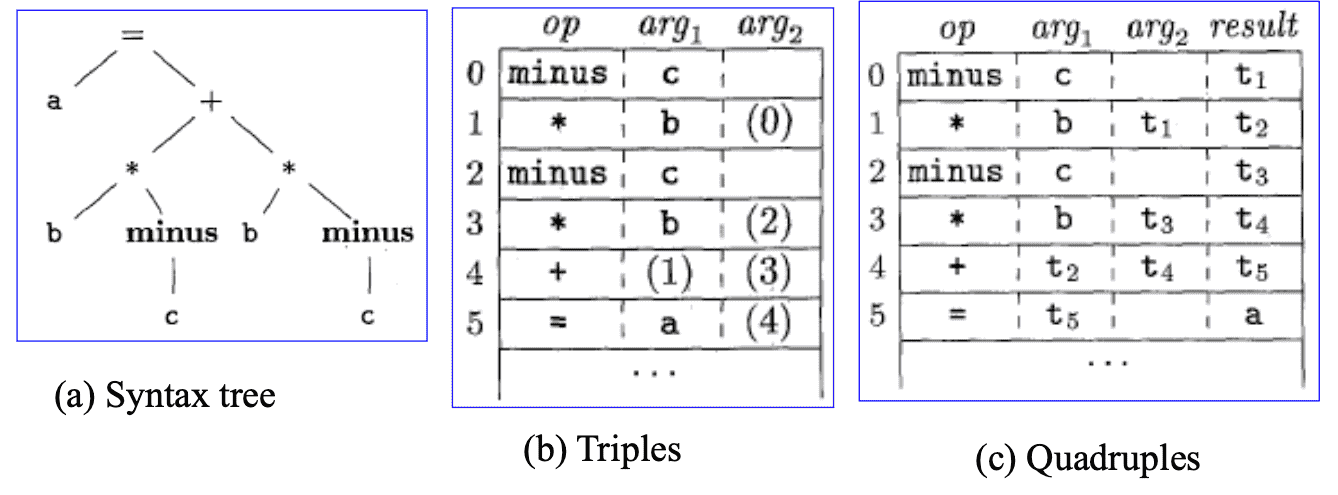
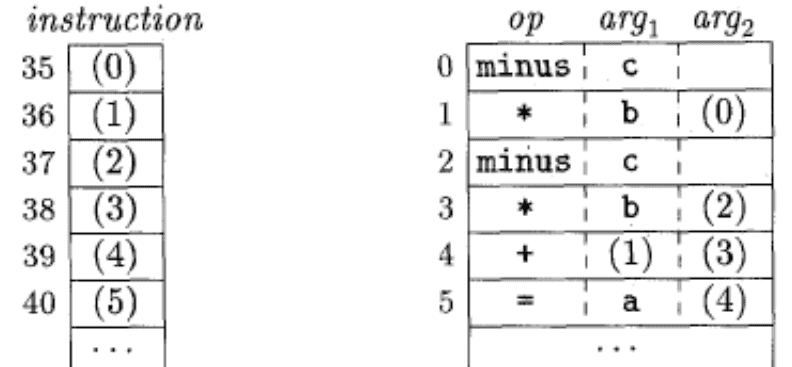
Translations: Arrays¶
Let
| BA | Base Address |
| W | Size of Element |
| \(R\) | Total number of rows |
| \(C\) | Total number of cols |
| \(L_r\) | Row starting index |
| \(L_c\) | Col starting index |
| \(i\) | Row index |
| \(j\) | Col index |
| 1D | \(\text{BA} + W*(i-L_r)\) |
| 2D | \(\text{BA} + W*[(i-L_r)*C + (j-L_c)]\) |
| … |
c + a[i][j] for int a[4][3];¶
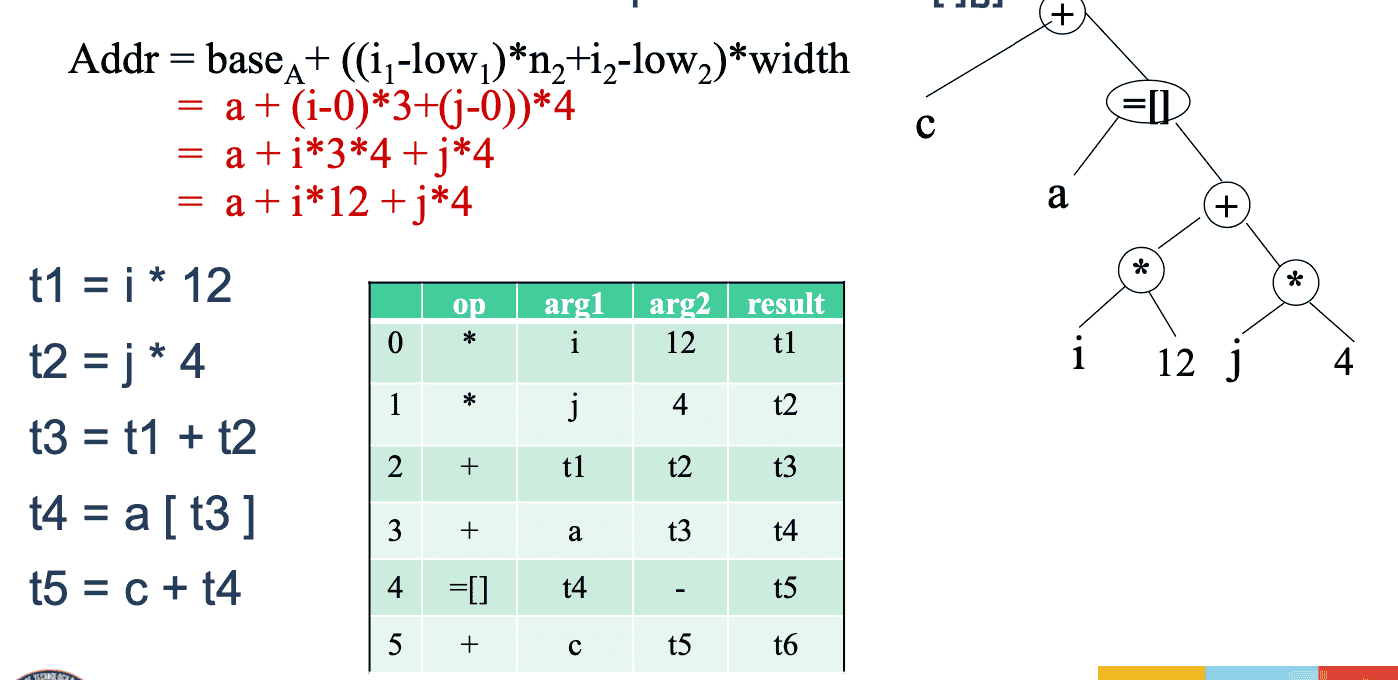
a = b[i] + c[i]¶
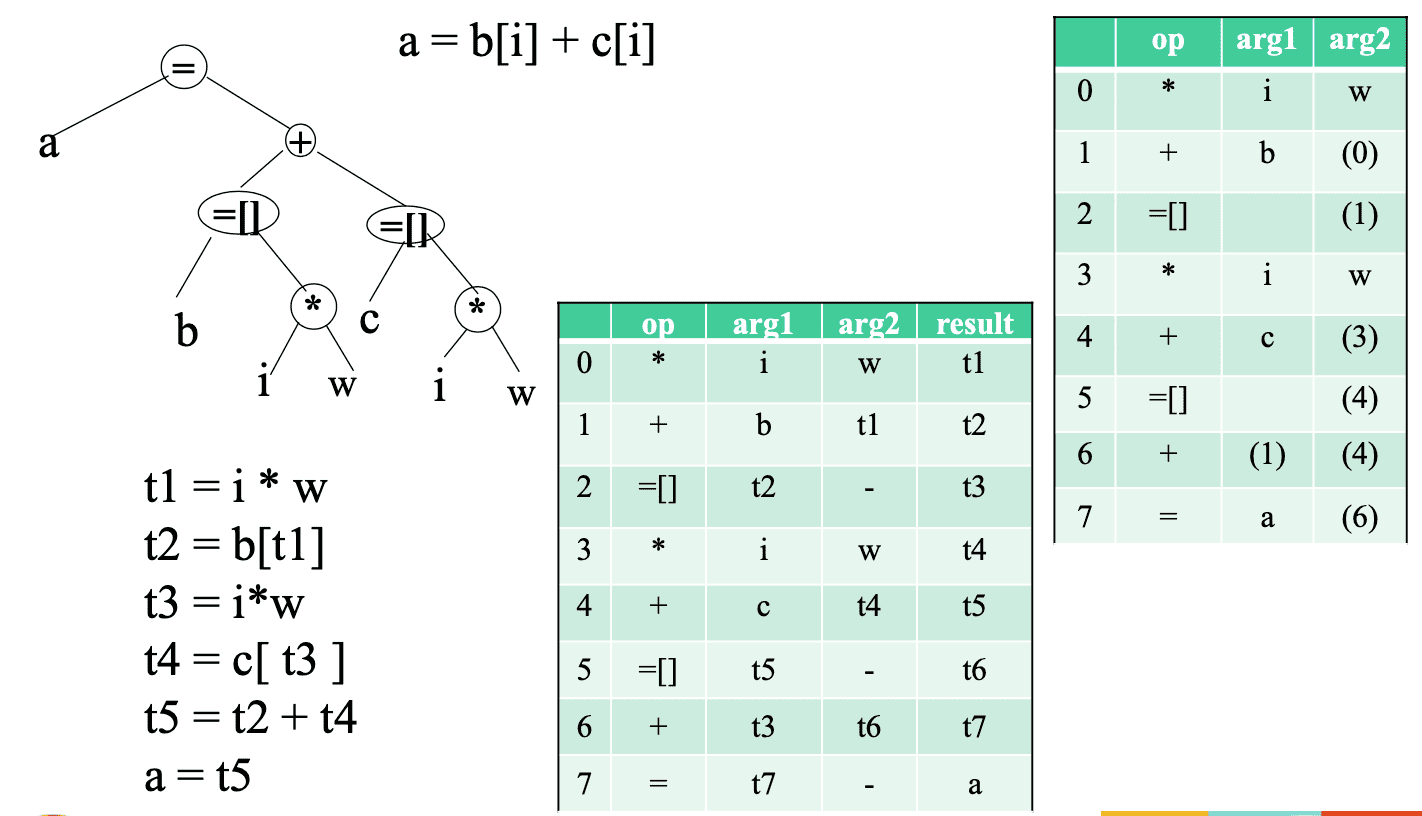
Correction: Row 6 for triple should be + (2) (5)
a[i] = b * c + b * d¶
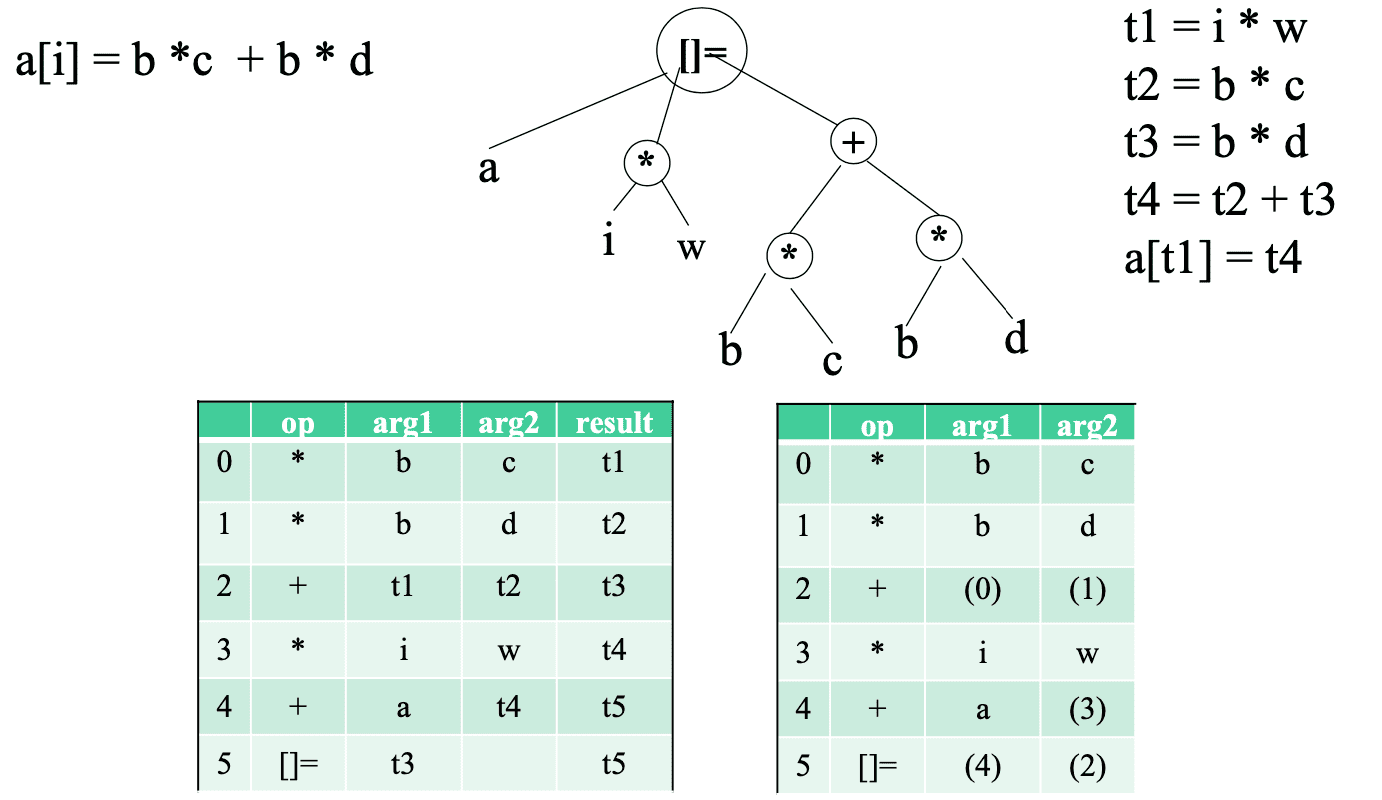
Flow Control¶
The translation of statements such as if-else- statements and while-statements is tied to the translation of boolean expressions
Boolean expressions
- alter flow of control
- compute logical values
Example¶
| op | arg1 | arg2 | result | |
|---|---|---|---|---|
| 0 | LABEL | L1 | ||
| 1 | < | a | b | t1 |
| 2 | iff (if false) | t1 | - | L2 |
| 3 | + | a | b | t2 |
| 4 | = | t2 | - | c |
| 5 | + | a | 1 | t3 |
| 6 | = | t3 | a | |
| 7 | goto | L1 | ||
| 8 | LABEL | L2 |
Example¶
| op | arg1 | arg2 | Result | |
|---|---|---|---|---|
| 0 | = | 0 | sum | |
| 1 | = | 0 | i | |
| 2 | LABEL | L1 | ||
| 3 | < | i | n | t1 |
| 4 | iff | t1 | - | L2 |
| 5 | + | sum | i | t2 |
| 6 | = | t2 | sum | |
| 7 | goto | L1 | ||
| 8 | LABEL | L2 |
Basic Blows & Flow Graphs¶
